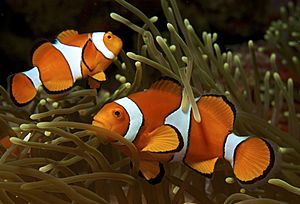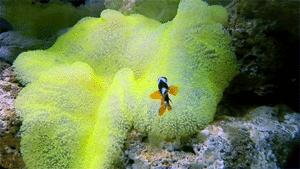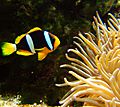Clownfish facts for kids
Quick facts for kids Clownfish |
|
|---|---|
 |
|
| Ocellaris clownfish (Amphiprion ocellaris) | |
| Scientific classification |
|
| Kingdom: | Animalia |
| Phylum: | Chordata |
| Class: | Actinopterygii |
| Order: | Perciformes |
| Suborder: | Labroidei |
| Family: | Pomacentridae |
| Subfamily: | Amphiprioninae Allen, 1975 |
| Genera | |
|
|
Clownfish, also known as anemonefish, are colorful fish that belong to the group called Amphiprioninae. There are about 30 different kinds, or species, of clownfish. Most of them are in the Amphiprion genus, but one is in the Premnas genus.
In the wild, clownfish live in a special partnership with sea anemones. This partnership is called a symbiotic mutualism, where both the fish and the anemone help each other. Clownfish can be yellow, orange, red, or even black. Many have white stripes or patches on their bodies. The biggest clownfish can grow to about 17 centimeters (6.7 inches) long, while the smallest are only about 7 to 8 centimeters (2.8 to 3.1 inches).
Contents
Where Do Clownfish Live?
Clownfish live in the warm waters of the Indian Ocean and the Pacific Ocean. You can find them in places like the Red Sea, the Great Barrier Reef, Southeast Asia, Japan, and the Indo-Malaysian region. Some types of clownfish live in only a small area, while others are found in many different places.
These fish usually live at the bottom of shallow seas. They prefer sheltered reefs or calm, shallow lagoons. You won't find any clownfish in the Atlantic Ocean.
What Do Clownfish Eat?
Clownfish are omnivores, which means they eat both plants and animals. They often eat leftover food scraps from their host anemones. The clownfish's waste also helps feed the sea anemone, providing it with important nutrients.
Their main diet is tiny animals called zooplankton that float in the water. This includes small creatures like copepods and tunicate larvae. They also eat a small amount of algae. However, one type, the Amphiprion perideraion, mostly eats algae.
Clownfish and Anemones: A Special Friendship
The relationship between clownfish and sea anemones is a great example of a symbiotic partnership. Both creatures get many benefits from living together. Each type of clownfish usually prefers a specific type of anemone.
The sea anemone protects the clownfish from other fish that might want to eat them. It also provides food from its own meals and sometimes even dead tentacles. The anemone also acts as a safe place for the clownfish to lay its eggs.
In return, the clownfish helps the anemone by chasing away predators and parasites. The clownfish's waste also gives nutrients to the anemone. The nitrogen from the clownfish helps the anemone grow and repair its tissues. Clownfish also swim around the anemone, which helps move water around its tentacles. Some scientists think their bright colors might even attract smaller fish for the anemone to catch!
Sometimes, sea anemones can become "bleached" if the water gets too warm. This means they lose the tiny algae that live inside them and give them color and food. When an anemone is bleached, it can be stressful for the clownfish living in it. Over time, the clownfish might not grow as well because there's less food available from the anemone.
You might wonder how clownfish can live among the anemone's stinging tentacles without getting hurt. Scientists have a few ideas:
- One idea is that the clownfish has a special slimy coating on its skin. This coating might be made of sugars instead of proteins. This could trick the anemone into not recognizing the fish as food, so it doesn't sting it.
- Another idea is that clownfish have slowly developed a way to resist the anemone's stings over many years. This is called coevolution. Even with this resistance, they aren't completely safe. If their special mucus coating is removed, they can still be stung.
Clownfish are the most famous fish that live with sea anemones, but a few others can too. These include young threespot dascyllus, some types of cardinalfish, and the incognito goby.
How Clownfish Reproduce
In a group of clownfish, there is a clear pecking order, or dominance hierarchy. The biggest and most bossy female is always at the top. Only two clownfish in a group will have babies: the female and one male. They lay their eggs and the male fertilizes them.
Clownfish are special because they are "protandrous sequential hermaphrodites." This means they are all born male. As they grow older, if the female of the group dies or is removed, the largest and most dominant male will change into a female! Then, the other males in the group move up in rank. This system helps prevent fights among the males.
Clownfish lay their eggs on a flat surface very close to their host anemone. In the wild, they usually lay eggs around the time of the full moon. Depending on the type of clownfish, they can lay hundreds or even thousands of eggs! The male parent takes care of the eggs until they hatch, which usually takes about 6 to 10 days. The eggs typically hatch about two hours after it gets dark.
Parental Care
A clownfish family usually includes the breeding male and female, plus a few younger males. These younger males help out with the family. Even though there are many males, only the adult male and female will reproduce. If the female dies, the breeding male changes into the new breeding female. The largest young male then quickly grows and becomes the new breeding male. This way, there's less fighting among the males for a female. For example, the younger males stay small on purpose so they don't threaten the adult male, which keeps them from being kicked out of the group.
Image:Clownfish in anemone off Vanuatu.ogg
The clownfish's breeding cycle often follows the moon's cycle. They lay eggs most often around the first and third quarters of the moon. This means the eggs hatch around the full moon or new moon. One reason for this might be that the highest tides happen during full or new moons. Hatching at night during high tide could help the baby fish escape predators because the stronger currents and more water can sweep them to safety. Before laying eggs, the parents clean the nest area by biting the anemone and the surface.
The female clownfish can lay anywhere from 600 to 1,500 eggs, depending on her size. Unlike many animals, the male clownfish does most of the work caring for the eggs. He fans them with his fins and guards them for 6 to 10 days until they hatch. When males fan the eggs properly, they develop faster. This shows that males can control how successful the hatching is by how much time and energy they put into caring for the eggs. For example, a male might fan less if food is scarce or more if there's plenty. Males also guard eggs more carefully if they are sure the eggs are theirs. Females, however, don't show as much interest in parental care as males. This all suggests that male clownfish put more effort into raising their young than females do.
Clownfish in Aquariums
Clownfish are very popular in the marine pet trade. About 43% of all marine ornamental fish sold globally are clownfish. About 25% of these come from fish bred in captivity, but most are still caught from the wild. This has led to fewer clownfish in some areas where they are caught.
Public aquariums and special breeding programs are very important for keeping clownfish available for aquariums. It has become possible to breed clownfish in captivity through their entire lifecycle. Some types of clownfish, like the maroon clownfish, can become aggressive in a tank. Others, like the false percula clownfish, can live peacefully with other clownfish of the same kind.
If a sea anemone isn't available in an aquarium, clownfish might live in other types of soft or stony corals. Once they choose a home, they will defend it. However, clownfish don't always need an anemone or coral to survive; they can live alone in captivity.
Clownfish in Popular Culture
In the popular Disney Pixar movie Finding Nemo (2003) and its sequel Finding Dory (2016), the main characters Nemo, his father Marlin, and his mother Coral are all clownfish. They are specifically A. ocellaris species. After Finding Nemo came out, more people wanted clownfish for their aquariums. It was the first movie that led to an increase in the number of fish caught from the wild.
Images for kids
-
Male P. biaculeatus (maroon anemonefish) in Papua New Guinea.
See also
 In Spanish: Pez payaso para niños
In Spanish: Pez payaso para niños










